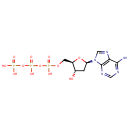| References: |
- Bennett, B. D., Kimball, E. H., Gao, M., Osterhout, R., Van Dien, S. J., Rabinowitz, J. D. (2009). "Absolute metabolite concentrations and implied enzyme active site occupancy in Escherichia coli." Nat Chem Biol 5:593-599. Pubmed: 19561621
- Bory C, Boulieu R, Souillet G, Chantin C, Guibaud P, Hershfield MS: Effect of polyethylene glycol-modified adenosine deaminase (PEG-ADA) therapy in two ADA-deficient children: measurement of erythrocyte deoxyadenosine triphosphate as a useful tool. Adv Exp Med Biol. 1991;309A:173-6. Pubmed: 1789201
- Bory C, Boulieu R, Souillet G, Chantin C, Rolland MO, Mathieu M, Hershfield M: Comparison of red cell transfusion and polyethylene glycol-modified adenosine deaminase therapy in an adenosine deaminase-deficient child: measurement of erythrocyte deoxyadenosine triphosphate as a useful tool. Pediatr Res. 1990 Aug;28(2):127-30. Pubmed: 2395602
- Chen SH, Ochs HD, Scott CR, Giblett ER, Tingle AJ: Adenosine deaminase deficiency: disappearance of adenine deoxynucleotides from a patient's erythrocytes after successful marrow transplantation. J Clin Invest. 1978 Dec;62(6):1386-9. Pubmed: 372236
- Cowan MJ, Shannon KM, Wara DW, Ammann AJ: Rejection of bone marrow transplant and resistance of alloantigen reactive cells to in vivo deoxyadenosine in adenosine deaminase deficiency. Clin Immunol Immunopathol. 1988 Nov;49(2):242-50. Pubmed: 2971490
- Dang-Vu AP, Olsen EA, Vollmer RT, Greenberg ML, Hershfield MS: Treatment of cutaneous T cell lymphoma with 2'-deoxycoformycin (pentostatin). J Am Acad Dermatol. 1988 Oct;19(4):692-8. Pubmed: 3263401
- Donofrio J, Coleman MS, Hutton JJ, Daoud A, Lampkin B, Dyminski J: Overproduction of adenine deoxynucleosides and deoxynucletides in adenosine deaminase deficiency with severe combined immunodeficiency disease. J Clin Invest. 1978 Oct;62(4):884-7. Pubmed: 308954
- Goday A, Simmonds HA, Webster DR, Levinsky RJ, Watson AR, Hoffbrand AV: Importance of platelet-free preparations for evaluating lymphocyte nucleotide levels in inherited or acquired immunodeficiency syndromes. Clin Sci (Lond). 1983 Dec;65(6):635-43. Pubmed: 6414755
- Grever MR, Siaw MF, Jacob WF, Neidhart JA, Miser JS, Coleman MS, Hutton JJ, Balcerzak SP: The biochemical and clinical consequences of 2'-deoxycoformycin in refractory lymphoproliferative malignancy. Blood. 1981 Mar;57(3):406-17. Pubmed: 6970050
- Gruber HE, Cohen AH, Firestein GS, Redelman D, Bluestein HG: Deoxy-ATP accumulation in adenosine deaminase-inhibited human B and T lymphocytes. Adv Exp Med Biol. 1986;195 Pt A:503-7. Pubmed: 3487921
- Hirschhorn R, Roegner V, Rubinstein A, Papageorgiou P: Plasma deoxyadenosine, adenosine, and erythrocyte deoxyATP are elevated at birth in an adenosine deaminase-deficient child. J Clin Invest. 1980 Mar;65(3):768-71. Pubmed: 6965496
- Hirschhorn R, Roegner-Maniscalco V, Kuritsky L, Rosen FS: Bone marrow transplantation only partially restores purine metabolites to normal in adenosine deaminase-deficient patients. J Clin Invest. 1981 Dec;68(6):1387-93. Pubmed: 7033281
- Hoffbrand AV, Ganeshaguru K, Hooton JW, Tattersall MH: Effect of iron deficiency and desferrioxamine on DNA synthesis in human cells. Br J Haematol. 1976 Aug;33(4):517-26. Pubmed: 1009024
- Ishii, N., Nakahigashi, K., Baba, T., Robert, M., Soga, T., Kanai, A., Hirasawa, T., Naba, M., Hirai, K., Hoque, A., Ho, P. Y., Kakazu, Y., Sugawara, K., Igarashi, S., Harada, S., Masuda, T., Sugiyama, N., Togashi, T., Hasegawa, M., Takai, Y., Yugi, K., Arakawa, K., Iwata, N., Toya, Y., Nakayama, Y., Nishioka, T., Shimizu, K., Mori, H., Tomita, M. (2007). "Multiple high-throughput analyses monitor the response of E. coli to perturbations." Science 316:593-597. Pubmed: 17379776
- Kanehisa, M., Goto, S., Sato, Y., Furumichi, M., Tanabe, M. (2012). "KEGG for integration and interpretation of large-scale molecular data sets." Nucleic Acids Res 40:D109-D114. Pubmed: 22080510
- Keseler, I. M., Collado-Vides, J., Santos-Zavaleta, A., Peralta-Gil, M., Gama-Castro, S., Muniz-Rascado, L., Bonavides-Martinez, C., Paley, S., Krummenacker, M., Altman, T., Kaipa, P., Spaulding, A., Pacheco, J., Latendresse, M., Fulcher, C., Sarker, M., Shearer, A. G., Mackie, A., Paulsen, I., Gunsalus, R. P., Karp, P. D. (2011). "EcoCyc: a comprehensive database of Escherichia coli biology." Nucleic Acids Res 39:D583-D590. Pubmed: 21097882
- Morgan G, Levinsky RJ, Hugh-Jones K, Fairbanks LD, Morris GS, Simmonds HA: Heterogeneity of biochemical, clinical and immunological parameters in severe combined immunodeficiency due to adenosine deaminase deficiency. Clin Exp Immunol. 1987 Dec;70(3):491-9. Pubmed: 3436096
- Nespoli L, Porta F, Locatelli F, Aversa F, Carotti A, Lanfranchi A, Gibardi A, Marchesi ME, Abate L, Martelli MF, et al.: Successful lectin-separated bone marrow transplantation in adenosine deaminase deficiency-related severe immunodeficiency. Haematologica. 1990 Nov-Dec;75(6):546-50. Pubmed: 2098297
- Peters GJ, De Abreu RA, Oosterhof A, Veerkamp JH: Concentration of nucleotides and deoxynucleotides in peripheral and phytohemagglutinin-stimulated mammalian lymphocytes. Effects of adenosine and deoxyadenosine. Biochim Biophys Acta. 1983 Aug 23;759(1-2):7-15. Pubmed: 6603870
- Schmalstieg FC, Mills GC, Tsuda H, Goldman AS: Severe combined immunodeficiency in a child with a healthy adenosine deaminase deficient mother. Pediatr Res. 1983 Dec;17(12):935-40. Pubmed: 6606796
- Simmonds HA, Fairbanks LD, Morris GS, Webster DR, Harley EH: Altered erythrocyte nucleotide patterns are characteristic of inherited disorders of purine or pyrimidine metabolism. Clin Chim Acta. 1988 Feb 15;171(2-3):197-210. Pubmed: 3370820
- Simmonds HA, Sahota A, Potter CF, Perrett D, Hugh-Jones K, Watson JG: Purine metabolism in adenosine deaminase deficiency. Ciba Found Symp. 1978;(68):255-62. Pubmed: 387357
- Simmonds HA, Webster DR, Perrett D, Reiter S, Levinsky RJ: Formation and degradation of deoxyadenosine nucleotides in inherited adenosine deaminase deficiency. Biosci Rep. 1982 May;2(5):303-14. Pubmed: 6980023
- van der Werf, M. J., Overkamp, K. M., Muilwijk, B., Coulier, L., Hankemeier, T. (2007). "Microbial metabolomics: toward a platform with full metabolome coverage." Anal Biochem 370:17-25. Pubmed: 17765195
- Waddell D, Ullman B: Characterization of a cultured human T-cell line with genetically altered ribonucleotide reductase activity. Model for immunodeficiency. J Biol Chem. 1983 Apr 10;258(7):4226-31. Pubmed: 6339493
- Zofall M, Bartholomew B: Two novel dATP analogs for DNA photoaffinity labeling. Nucleic Acids Res. 2000 Nov 1;28(21):4382-90. Pubmed: 11058139
|
|---|


